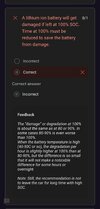This question is misleading.
The question asking if 100% is damaging and not if 100% damages the same as 80%.
Reading the question implies "if 100% as a general rule damage the battery" but the answer is for a different question.
The answer is for a question asking "which SoC damages the most" in which answering 100% would be incorrect.
1. Is staying at 100% damage the battery: yes
2. Is staying at 80% damage the battery: yes
Both statements are correct. it's also true that both SoC have similar degradation and 80% may be even worse.
Even in the your answer feedback, you always compare 100% to 80%.
The question should be:
A lithium ion battery will gets damaged "more" at 100%.
In which the answer would be incorrect.
The truth is that the battery is not damaged at 100%.
If we went to a store and buy one of a few lihtium ion batteries, for example Panasonic NCR18650, that is closesly related to the Model S cells, if not exactly the same in some cases we will get a manual/specification stating this:
- Charge voltage 4.20V (compares to 100% in the tesla.)
- End of discharge 2.50V (way below 0% on the Tesla screen, and probably a bit below where the Tesla stops.
-There are numbers for which charging amps and discharging amps etc, but there are no precautions not to charge to 100% and leave them there. In fact, many of the areas of use of such lithium ion batteries involve charging them to 100% and leaving them there for long time.
My robot lawn mower always charge its 18650 full, and leaves it at that. It charge full after each lawning session, And sleeps for the rest of the 18h that day at 100%. For the winter, which is 6 months+ here, it should be charged full and stored.
I have some 18650 used for a battery pack for a FPV kit and they are charged full and then left in the pack for ”always”. After each use, I charge them full and leave them in the garage. Last time i measured the capacity it was on the track per the NMC research reports, I think these was 6 years. Time to check again, closing in to 8 years.
My Tesla model 3 cells(panasonic NCR2170), some of them, still are at 100% and closing in to 2 years. They are doing fine and actually has slightly less degradation than the 80% ones.
So, the per manufacturer spec,
they do not get damaged by sitting at 100% but they degrade slowly as all batteries we know of so far.
The question is thought to give that understanding, maybe I need to look over the explanation?



